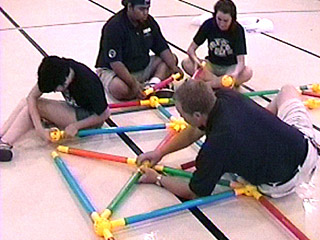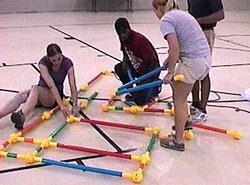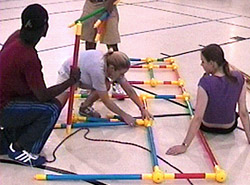Activity 15: No Loose Ends



No Loose Ends Activity
Activity Plan
Group Size: 2 - 5
Time: 10 - 45 minutes
Mental Intensity: 2
Physical Intensity: 1
Space: Minimal
Objectives
- Brainstorm and communicate to develop strategies to build a structure with no loose ends
- To find new ways of connecting the Toobeez and with each other
- Discuss the experience and their feelings
Character Focus
Perseverance
Preparation
Time: 1 minute
Materials:
1 Toobeez set per group
1 envelope
chart paper (optional)
Setup:
- Place the Risk Taking Note into an envelope.
- Supply each group with one set of Toobeez.
The Challenge
Create a structure with no loose ends.
Safety Reminders!
Appropriate caution is important to conduct these activities in a safe manner. Be sure to review these reminders prior to beginning the activity, and if necessary, share reminders with the group during the activity.
- Follow general safety procedures
Helpful hints
- This is a real puzzle of an activity, and it can take some groups five minutes while others will struggle for 30 minutes
Activity Instructions
- Circle up the group. Distribute or display the appropriate “Risk Taking Note” for the activity. Have one participant read it aloud twice. Provide a few moments for the participants to think about the message:
When you come to a wall, sometimes you climb, and sometimes you find a new way to use it! - Share the following storyline with group.
Imagine that the Toobeez are tunnels. You are building a secret tunnel system that will allow you to travel anywhere you want to go without ever running into a wall. - Read aloud the following Activity Challenge Box to the group.
Challenge: Create a structure with no loose ends. Follow the guidelines below:- There can be no “loose ends” in the structure. A person traveling through these “tunnels” should never encounter a dead end
- The Toobeez must be connected in the normal way. No bending or reconfiguring the tubes or balls to force a fit to the point that the tube and/or ball is damaged
- If any guidelines are broken, the group must begin again
- Before the participants attempt an activity challenge, have the group work through the following six steps:
- Circle up
- Know and understand the challenge and the guidelines
- Brainstorm
- Make a plan
- Do the plan
- Evaluate results and adjust as necessary
- If participants get stuck, have the students circle up again. Here are some suggested questions to help guide the group back on track*:
- What is working?
- What ideas have you not tried yet that someone suggested?
- If your group is still struggling OR if you feel your group would benefit from an additional challenge, present a variation provided on the next page.
- After the activity, move to the debriefing questions for discussion.


Problem Solving Sequence:
Activity Variations
- Build in three dimensions.
This activity is easier when you allow the group to build their structure in three dimensions. Requiring the group to build in only two dimensions (i.e. flat on the floor) is more difficult.
Debriefing the Activity
Use these debriefing questions as a guide for your discussion. Select the questions you feel will best benefit your group. It is not mandatory to cover every question. If possible, record the group’s responses on flip chart paper so all comments are displayed. Make sure to let everyone share their ideas, and remind participants that everyone’s opinions and feelings are important!
Base questions for debriefing:
- How did you feel while you did the activity?
- What are the pluses and minuses of a closed system?
- Is your school an open or closed system?
- What was one of the challenges of doing this activity?
- What advice would you give to another group working on this activity?
- What did the group have to do or believe to be successful?
- How can you apply what you learned in this activity to your life and work?
- What surprised you about this activity?
If the group was unable to complete the task in the given time:
- What did a fellow team member do that was really helpful?
- Since you were not able to solve the problem, does it mean your group is a failure? (Push the group to respond with more than a “yes” or “no” and to instead point out and discuss what they learned.)
- How do you feel now?
Additional questions: Choose which ones are the most appropriate:
- What was one positive thing that happened during the challenge?
- How do you work to keep improving your work with others?
- Did you try different ideas? If so, why did you change your approach?
Close on a Positive Note
Sum up the different ideas and feelings that you heard expressed, and restate ideas and learning moments the participants shared. Then, read the Risk Taking Note out loud again, and ask people to discuss what they think this note means. Discuss what they thought it meant at the beginning and what they think it means now.
* (ˆ) Do not provide the participants with answers. Allow them to work together.





